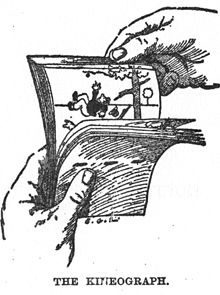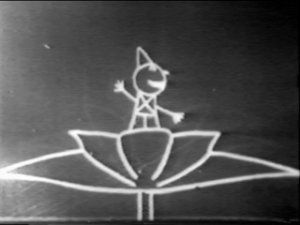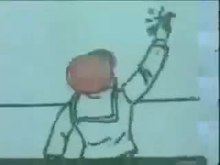History of journalism
The history of journalism, or the development of the gathering and transmitting of news, spans the growth of technology and trade, marked by the advent of specialized techniques for gathering and disseminating information on a regular basis that has caused, as one history of journalism surmises, the steady increase of "the scope of news available to us and the speed with which it is transmitted. Before the printing press was invented, word of mouth was the primary source of news. Returning merchants, sailorsand travelers brought news back to the mainland, and this was then picked up by pedlars and travelling players and spread from town to town. This transmission of news was highly unreliable, and died out with the invention of the printing press. Newspapers have always been the primary medium of journalists since 1700, with magazines added in the 18th century, radio and television in the 20th century, and the Internet in the 21st century.[1]
Early Journalism[edit]
World[edit]
Before the advent of the newspaper, there were two major kinds of periodical news publications: the handwritten news sheet, and single item news publications. These existed simultaneously.
The Roman Empire published Acta Diurna ("Daily Acts"), or government announcement bulletins, around 59 BC, as ordered by Julius Caesar. They were carved in metal or stone and posted in public places.
In China, early government-produced news sheets, called tipao, were commonly used among court officials during the late Han dynasty (2nd and 3rd centuries AD).
Europe[edit]
In 1556, the government of Venice first published the monthly Notizie scritte ("Written notices") which cost one gazetta,[2] a Venetian coin of the time, the name of which eventually came to mean "newspaper". These avvisi were handwritten newsletters and used to convey political, military, and economic news quickly and efficiently throughoutEurope, more specifically Italy, during the early modern era (1500-1800) — sharing some characteristics of newspapers though usually not considered true newspapers.[3]
However, none of these publications fully met the modern criteria for proper newspapers, as they were typically not intended for the general public and restricted to a certain range of topics.
Early publications played into the development of what would today be recognized as the newspaper, which came about around 1601. Around the 15th and 16th centuries, in England and France, long news accounts called "relations" were published; in Spain they were called "relaciones".
Single event news publications were printed in the broadsheet format, which was often posted. These publications also appeared as pamphlets and small booklets (for longer narratives, often written in a letter format), often containing woodcut illustrations. Literacy rates were low in comparison to today, and these news publications were often read aloud (literacy and oral culture were, in a sense, existing side by side in this scenario).
By 1400, businessmen in Italian and German cities were compiling hand written chronicles of important news events, and circulating them to their business connections. The idea of using a printing press for this material first appeared in Germany around 1600. The first gazettes appeared in German cities, notably the weekly Relation aller Fuernemmen und gedenckwürdigen Historien ("Collection of all distinguished and memorable news") in Strasbourg starting in 1605. The Avisa Relation oder Zeitung was published in Wolfenbüttel from 1609, and gazettes soon were established in Frankfurt (1615), Berlin (1617) and Hamburg (1618). By 1650, 30 German cities had active gazettes.[4] A semi-yearly news chronicle, in Latin, the Mercurius Gallobelgicus, was published at Cologne between 1594 and 1635, but it was not the model for other publications.
The news circulated between newsletters through well-established channels in 17th century Europe. Antwerp was the hub of two networks, one linking France, Britain, Germany, and the Netherlands; the other linking Italy Spain and Portugal. Favorite topics included wars, military affairs, diplomacy, and court business and gossip.[5]
After 1600 the national governments in France and England began printing official newsletters.[6] In 1622 the first English-language weekly magazine, "A current of General News" was published and distributed in England[7] in an 8- to 24-page quarto format.
The first newspaper in France, the Gazette de France, was established in 1632 by the king's physician Theophrastus Renaudot (1586-1653), with the patronage of Louis XIII.[8]All newspapers were subject to prepublication censorship, and served as instruments of propaganda for the monarchy. Jean Loret is considered to be one of France's first journalists. He disseminated the weekly news of music, dance and Parisian society from 1650 until 1665 in verse, in what he called a gazette burlesque, assembled in three volumes of La Muse historique (1650, 1660, 1665).
Main articles: History of newspaper publishing § India and List of newspapers in India
The first newspaper in India was circulated in 1780 under the editorship of James Augustus Hickey. Named The Bengal Gazette ,[9] it mainly printed the latest gossip on the British expatriate population in India. On May 30, 1826 Udant Martand (The Rising Sun), the first Hindi-language newspaper published in India, started from Calcutta (nowKolkata), published every Tuesday by Pt. Jugal Kishore Shukla.[10][11] Maulawi Muhammad Baqir in 1836 founded the first Urdu-language newspaper the Delhi Urdu Akhbar. India's press in the 1840s was a motley collection of small-circulation daily or weekly sheets printed on rickety presses. Few extended beyond their small communities and seldom tried to unite the many castes, tribes, and regional subcultures of India. The Anglo-Indian papers promoted purely British interests. Englishman Robert Knight (1825-1890) founded two important English-language newspapers that reached a broad Indian audience, The Times of India and the Statesman. They promoted nationalism in India, as Knight introduced the people to the power of the press and made them familiar with political issues and the political process.[12]
Latin America[edit]
British influence extended globally through its colonies and its informal business relationships with merchants in major cities. They needed up-to-date market and political information. El Mercurio was founded in Valparaiso, Chile, in 1827. The most influential newspaper in Peru, El Comercio, first appeared in 1839. The Jornal do Commercio was established in Rio de Janeiro, Brazil, in 1827. Much later Argentina founded its newspapers in Buenos Aires: La Prensa in 1869 and La Nacion in 1870.[13]
Radio and television[edit]
Main article: History of broadcasting
The history of radio broadcasting begins in the 1920s, and reached its apogee in the 1930s and 1940s. Experimental television was being studied before the 2nd world war, became operational in the late 1940s, and became widespread in the 1950s and 1960s, largely but not entirely displacing radio.
Internet journalism[edit]
Further information: Online journalism and online newspapers
The rapidly growing impact of the Internet, especially after 2000, brought "free" news and classified advertising to audiences that no longer cared for paid subscriptions. The Internet undercut the business model of many daily newspapers. Bankruptcy loomed across the U.S. and did hit such major papers as the Rocky Mountain news (Denver), theChicago Tribune and the Los Angeles Times, among many others. Chapman and Nuttall find that proposed solutions, such as multiplatforms, paywalls, PR-dominated news gathering, and shrinking staffs have not resolved the challenge. The result, they argue, is that journalism today is characterized by four themes: personalization, globalization, localization, and pauperization.[14]
Historiography[edit]
Journalism historian David Nord has argued that in the 1960s and 1970s:
- "In journalism history and media history, a new generation of scholars . . . criticised traditional histories of the media for being too insular, too decontextualised, too uncritical, too captive to the needs of professional training, and too enamoured of the biographies of men and media organizations."[15]
In 1974, James W. Carey identified the ‘Problem of Journalism History’. The field was dominated by a Whig interpretation of journalism history.
- "This views journalism history as the slow, steady expansion of freedom and knowledge from the political press to the commercial press, the setbacks into sensationalism and yellow journalism, the forward thrust into muck raking and social responsibility....the entire story is framed by those large impersonal forces buffeting the press: industrialisation, urbanisation and mass democracy.[16]
O'Malley says the criticism went too far, because there was much of value in the deep scholarship of the earlier period.[17]
- Asia[edit]
- Huang, C. "Towards a broadloid press approach: The transformation of China's newspaper industry since the 2000s." Journalism 19 (2015): 1-16. online, With bibliography pages 27-33.
Britain[edit]
- Andrews, Alexander. The history of British journalism: from the foundation of the newspaper press in England, to the repeal of the Stamp act in 1855 (1859). online old classic
- Briggs Asa. The BBC—the First Fifty Years (Oxford University Press, 1984).
- Briggs Asa. The History of Broadcasting in the United Kingdom (Oxford University Press, 1961).
- Clarke, Bob. From Grub Street to Fleet Street: An Illustrated History of English Newspapers to 1899 (Ashgate, 2004)
- Crisell, Andrew An Introductory History of British Broadcasting. (2nd ed. 2002).
- Herd, Harold. The March of Journalism: The Story of the British Press from 1622 to the Present Day (1952).
- Jones, A. Powers of the Press: Newspapers, Power and the Public in Nineteenth-Century England (1996).
- Lee, A. J. The Origins of the Popular Press in England, 1855–1914 (1976).
- Marr, Andrew. My trade: a short history of British journalism (2004)
- Scannell, Paddy, and Cardiff, David. A Social History of British Broadcasting, Volume One, 1922-1939 (Basil Blackwell, 1991).
- Silberstein-Loeb, Jonathan. The International Distribution of News: The Associated Press, Press Association, and Reuters, 1848–1947 (2014).
- Wiener, Joel H. "The Americanization of the British press, 1830—1914." Media History 2#1-2 (1994): 61-74.
British Empire[edit]
- Cryle, Denis. Disreputable profession: journalists and journalism in colonial Australia (Central Queensland University Press, 1997).
- Harvey, Ross. "Bringing the News to New Zealand: the supply and control of overseas news in the nineteenth century." Media History 8#1 (2002): 21-34.
- Kesterton, Wilfred H. A history of journalism in Canada (1967).
- Pearce, S. Shameless Scribblers: Australian Women’s Journalism 1880–1995 (Central Queensland University Press, 1998).
- Sutherland, Fraser. The monthly epic: A history of Canadian magazines, 1789-1989 (1989).
- Vine, Josie. "If I Must Die, Let Me Die Drinking at an Inn': The Tradition of Alcohol Consumption in Australian Journalism" Australian Journalism Monographs (Griffith Centre for Cultural Research, Griffith University, vol 10, 2010) online; bibliography on journalists, pp 34-39
- Walker, R.B. The Newspaper Press in New South Wales: 1803 – 1920 (1976).
- Walker, R.B. Yesterday’s News: A History of the Newspaper Press in New South Wales from 1920 to 1945 (1980).
United States[edit]
- Barnouw Erik. The Golden Web (Oxford University Press, 1968); The Image Empire: A History of Broadcasting in the United States, Vol. 3: From 1953 (1970) excerpt and text search; The Sponsor (1978); A Tower in Babel (1966), to 1933, excerpt and text search; a history of American broadcasting
- Blanchard, Margaret A., ed. History of the Mass Media in the United States, An Encyclopedia. (1998)
- Craig, Douglas B. Fireside Politics: Radio and Political Culture in the United States, 1920-1940 (2005)
- Emery, Michael, Edwin Emery, and Nancy L. Roberts. The Press and America: An Interpretive History of the Mass Media 9th ed. (1999.), standard textbook; best place to start.
- McCourt; Tom. Conflicting Communication Interests in America: The Case of National Public Radio (Praeger Publishers, 1999) online
- McKerns, Joseph P., ed. Biographical Dictionary of American Journalism. (1989)
- Marzolf, Marion. Up From the Footnote: A History of Women Journalists. (1977)
- Mott, Frank Luther. American Journalism: A History of Newspapers in the United States Through 250 Years, 1690-1940 (1941). major reference source and interpretive history. online edition
- Nord, David Paul. Communities of Journalism: A History of American Newspapers and Their Readers. (2001) excerpt and text search
- Schudson, Michael. Discovering the News: A Social History of American Newspapers. (1978). excerpt and text search
- Sloan, W. David, James G. Stovall, and James D. Startt. The Media in America: A History, 4th ed. (1999)
- Starr, Paul. The Creation of the Media: Political origins of Modern Communications (2004), far ranging history of all forms of media in 19th and 20th century US and Europe; Pulitzer prize excerpt and text search
- Streitmatter, Rodger. Mightier Than the Sword: How the News Media Have Shaped American History (1997)online edition
- Vaughn, Stephen L., ed. Encyclopedia of American Journalism (2007) 636 pages excerpt and text search
Magazines[edit]
- Angeletti, Norberto, and Alberto Oliva. Magazines That Make History: Their Origins, Development, and Influence (2004), covers Time, Der Spiegel, Life, Paris Match, National Geographic, Reader's Digest, ¡Hola!, and People
- Brooker, Peter, and Andrew Thacker, eds. The Oxford Critical and Cultural History of Modernist Magazines: Volume I: Britain and Ireland 1880-1955 (2009)
- Haveman, Heather A. Magazines and the Making of America: Modernization, Community, and Print Culture, 1741-1860 (Princeton University Press, 2015)
- Mott, Frank Luther. A History of American Magazines (five volumes, 1930-1968), detailed coverage of all major magazines, 1741 to 1930.
- Summer, David E. The Magazine Century: American Magazines Since 1900 (Peter Lang Publishing; 2010) 242 pages. Examines the rapid growth of magazines throughout the 20th century and analyzes the form's current decline.
- Wood, James P. Magazines in the United States (1971)
- Würgler, Andreas. National and Transnational News Distribution 1400–1800, European History Online, Mainz: Institute of European History),(2010) Journalists around the world are also arrested.
Source: http://bit.ly/1WMVG4R








